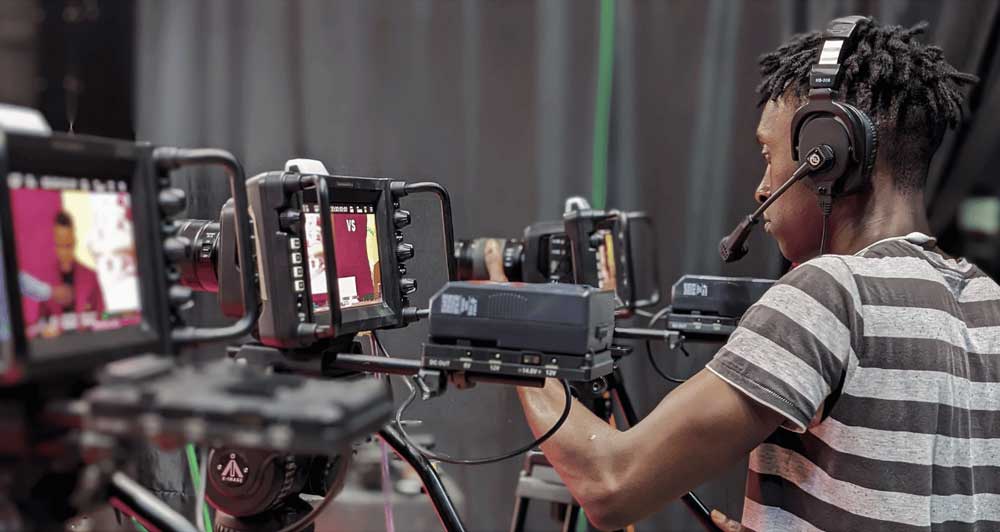
“Editing feels almost like sculpting or a form of continuing the writing process.” – Sydney Pollack
Effective video production can be the difference between a forgotten message and a memorable brand story. In today’s content-saturated market, knowing how to craft a video that captivates and conveys your message is key. From selecting the right equipment to honing your editing skills and video production services, our guide delivers no-fluff, direct insights for elevating your media production quality – because your audience expects nothing less than exceptional.
Key Takeaways
- Video production encompasses pre-production, production, and post-production stages, necessitating careful planning, skilled team coordination, and meticulous execution at each phase to ensure high-quality output and effective storytelling.
- A successful video content strategy involves identifying target audiences and choosing optimal marketing channels for distribution, utilizing analytics for performance measurement, and continuously optimizing content based on feedback.
- High-quality video production significantly enhances a brand’s image, offers a dynamic medium for storytelling, and effectively conveys the brand’s message to engage the target audience, which underscores the importance of investing in professional production teams and techniques.

Understanding Video Production
The creation of videos is a complex operation that goes beyond simple image capture. Resembling the craft of moviemaking, it involves the recording of video rather than using traditional film stock. A variety of services are provided by video production companies to cater to unique client demands, showcasing their capability in this adaptable medium. The objective is to convey the brand’s character, emotions, and values effectively through visual storytelling.
In parallel with movie production techniques, methodical planning and assembling a proficient team with diverse talents are crucial for prosperous outcomes in creating videos. Each phase within the process requires distinctive skill sets and knowledge pools. From ideation all the way through to fruition, every step is pivotal for crafting quality content which resonates impactfully.
As digital channels become more dominant tools in commerce communications globally, incorporating video into marketing strategies has proven vital due to its power to captivate audiences dynamically while disseminating messages cogently about one’s brand identity or product offerings — yet realizing compelling visuals entails much more than meets the eye: profound insight into each stage coupled with meticulous attention-to-detail remains paramount throughout.
Characterized by three fundamental phases — pre-production where groundwork is established. Actual production involving shooting material on-set or on-location. Followed by post-production entailing editing and refining raw footage, all combine systematically contributing uniquely toward sculpting an envisioned story visually ready for public presentation or consumption.
Pre-Production Essentials
Before any filming can commence, there is a substantial amount of planning and organization required. This initial phase is known as pre-production, and it lays the foundation for the entire video production process. Establishing clear objectives early on in the pre-production ensures that the end result will fulfill its intended goals and meet established success criteria. It’s essential to carefully contemplate what message the video intends to convey, who comprises its target audience, and through which channels it will be disseminated.
Project management also plays an integral role during this stage by:
- Defining project limits and budget constraints
- Securing professionals whose skills align with the creative needs of the project
- Guaranteeing all necessary resources are at hand when needed throughout production
The Production Phase

Following the completion of all preparatory work, the actual shooting begins. The production phase stands as the epicenter of activity, centered on securing high-quality visual and audio recordings that will underpin the end product. This encompasses:
- Positioning cameras and microphones to record crisp visuals in good lighting along with pristine sound.
- Guiding actors and documenting their renditions.
- Achieving proper shot framing and composition.
- Keeping a close eye on audio levels for any necessary modifications.
- Orchestrating lighting setups to produce the intended ambiance.
During this critical stage, a creative director’s responsibilities include:
- Steering collaboration among team members.
- Controlling both output quality and adherence to deadlines.
- Making certain that there’s consistency between video content and original idea.
- Upholding standards established during pre-production.
To ensure an effective production process, here are some tactics worth considering:
- Employ dual-camera arrangements for smoother transitions amidst scenes.
- Record supplementary b-roll footage as it facilitates easier editing transitions.
- Maintain up-to-date lists for shots and equipment inventory, ensuring organized operation throughout filming sessions.
The most challenging yet exhilarating segment within the video production process is undoubtedly the production phase. It demands significant coordination and collective effort so that every scene outlined in planning gets filmed accordingly while keeping track of all gear used. Despite potential difficulties faced during this time frame. It signifies when initial concepts start taking tangible form.
Post-Production Precision
After the cameras stop rolling, the transformative phase of post-production takes place. During this stage, editors transform raw footage into a cohesive and engaging narrative for viewers. Integral to this process are transitions and special effects that give greater dimensionality and continuity to the story in the final video.
Editors may employ cross dissolves as an effective tool during editing to denote temporal shifts or explore multiple aspects of a story simultaneously, thus enhancing its complexity and depth. Fades and dissolves act as visual signposts for audience members by signaling scene changes or highlighting key narrative moments.
The editor’s talent truly shines in post-production where their astute shot selection weaves together scenes into an effortless progression that maintains viewer interest. They elevate sensory appeal with the strategic addition of soundtracks, sound effects, and visual enhancements.
Meticulous color correction along with audio balancing is applied ensuring both aesthetic quality and auditory clarity within the video—a crafted piece destined not only to captivate but also deeply connect with its intended target audience.
Crafting Your Video Content Strategy
As the digital landscape increasingly emphasizes the importance of video content, crafting a comprehensive video marketing strategy has become crucial. Such a strategy is pivotal for efficient resource management and aligning every choice with both the intended purpose of your videos and the actions you want your audience to take.
Video content that makes an enduring impact on its viewers can inspire them to engage more deeply with it. Video stands out as a leading tool for engagement across the globe in digital marketing efforts. Producing compelling video material that not only grabs but also holds viewer interest, nudging them toward interaction with your brand, is key.
Key elements of robust video marketing include:
- Employing relevant metrics to monitor advancements
- Customizing videos according to different platform requirements and user behaviors
- Boosting levels of engagement through the strategic use of video
Effective teamwork in developing successful video projects requires clear channels for communication along with well-defined expectations—this ensures seamless collaboration while consistently conveying your brand’s core values and identity within all aspects of your corporate image.
Identifying Your Target Audience

The first step in developing a compelling video content strategy is to pinpoint your target audience. Conducting research on the viewers allows creators of video content to gain insights into their inclinations and requirements. It has been observed, for instance, that there’s a notable preference among users for videos that are instructional or teach them how-to.
To properly identify who will be watching your video content, tactics like deploying surveys, scrutinizing customer data, and monitoring conversations on social platforms can prove invaluable. Such gathered information plays a pivotal role in crafting videos that strike a chord with your audience by catering to their interests.
When it comes to tailoring video content specifically for popular social media platforms such as TikTok:
- The focus should be given to producing originality-driven, creative output poised for sharing
- Videos should appeal predominantly to younger demographics
- The creation process must take into account the particular viewing tendencies and preferences attributed to the intended demographic
This underscores just how crucial comprehending the target market really is.
Creating engaging professional videos hinges upon thorough editing processes which incorporate findings from audience analysis — ensuring alignment with what viewers seek out both interest-wise and need-based. By doing so you guarantee not only visual captivation but also harmony between the final product delivery and viewer preferences.
Choosing the Right Marketing Channels
Determining the optimal marketing channels is crucial for the effective dissemination of video content. Recognizing distinctions between platforms allows marketers to target specific audiences more successfully.
Today’s landscape presents a variety of video marketing avenues, which include:
- YouTube as a dominant platform for hosting videos
- Outstream video advertisements
- Sponsored Brands videos
- Programmatic purchases of streaming TV commercials
Each medium provides unique access to different viewer segments.
Noticing that many users on social media consume video content without sound, market strategists are adapting by focusing on compelling visuals and including subtitles in their videos. This adaptation underscores the importance of customizing content according both to whom it aims at reaching and how they typically watch such material across various services.
Selecting an appropriate mix of marketing channels can markedly boost both visibility and influence associated with one’s video materials. Ensuring delivery occurs directly to intended demographics greatly enhances potential interactions with those materials and likelihoods they lead toward desired actions or results.
Measuring Success Through Analytics
It is crucial to track the performance of your video content in order to assess its effectiveness and refine subsequent material. To determine and evaluate the success of any video marketing strategy, a strong grasp of video analytics is necessary. Important metrics that should be considered include view count, play rate, completion rate, engagement rate, and sharing rate.
These indicators offer significant insight into how well your content performs as well as viewer interactions with it.
For an effective approach to video marketing, setting SMART goals (Specific, Measurable, Achievable, Relevant, Time-bound) coupled with implementing feedback for continuous enhancement of your video content is vital. This process ensures perpetual advancement and adaptation of your content so that it aligns seamlessly with audience shifts in interests and demands.
Collecting more analytics data than can feasibly be evaluated should be avoided. Instead, focus on insights that are actionable. By doing this, you ensure that gathered data has practical utility guiding future endeavors in creating content along with optimizing the overarching marketing strategies.
The Art of Commercial Video Production
The process of producing commercial videos is a blend of artistic vision and strategic planning, aimed at delivering the core message of a brand. It commences by fully grasping what the client hopes to achieve and the effect they intend to have. The video content produced not only highlights the offerings from the brand but also communicates its core values and distinctive character.
In crafting a commercial, there’s an intricate teamwork among creative talents where roles such as that assumed by a commercial producer are critical in steering everything from idea inception to project fulfillment. This collective effort guarantees that each piece resonates with what the brand stands for while meeting their marketing goals.
Feedback from clients has been significant regarding both quality and how well-received their commercials were — highlighting how essential video content is for enhancing brands’ prestige and amplifying their messaging.
Collaboration with Marketing Teams
The efficacy of a commercial video relies on the seamless integration between the client’s marketing team and the production crew. Directors with expertise in commercials, like Staci Talley, join forces intimately with clients and their marketing divisions to bring a video project’s vision into fruition.
Such cooperation is pivotal for:
- Ensuring that the video aligns harmoniously with overarching company marketing strategies and ambitions.
- Maintaining brand consistency across all facets of its market presence through coherent messaging in videos.
- Reinforcing an integrated identity for the brand through various campaigns.
When different agencies pool together their specialized skills within collaborative ventures, it can elevate the effectiveness of entire video marketing efforts. This convergence infuses varied abilities and insights which often sparks novel concepts enriching these initiatives.
In essence, effective teamwork within commercial videography paves the way for outcomes such as:
- Videos that are true representations of what a brand stands for.
- Content that engages deeply with intended demographics.
- Results meeting not only customer expectations but also realizing predefined promotional goals.
This makes collaboration an indispensable element within any strategy concerning corporate film-making or advertising tasks.
Delivering the Client’s Message
Creating a commercial video that effectively communicates the client’s message requires an in-depth understanding of both the brand and its target audience. This entails developing a narrative and visual style that not only complements the brand but also engages with viewers on a deeper level. The creative director plays an essential role by:
- Molding the narrative and visuals of the video.
- Ensuring they accurately represent both the essence and communications of the brand.
- Possessing comprehensive knowledge about what makes up the company, including its core principles and values, as well as who is meant to consume its products or services.
In achieving this connection, testimonial videos prove incredibly valuable. Companies such as Creative Roots Media excel in crafting authentic customer narratives that harness real-life accounts to establish rapport with potential clients.
The crux of delivering a message from our clients hinges on forging an affinity between consumers and brands. It involves narrating tales that do more than exhibit goods or offerings – these stories embody what lies at heart within any given organization’s ethos and aspirations.
Video Editing Techniques for Impactful Storytelling
Video editing involves sculpting the raw footage obtained during the production phase into a compelling story. It stands as an essential component of the video production process, where storytelling is refined and given structure through judicious cuts, transitions, and effects. This stage demands not only narrative insight but also meticulous attention to detail.
The objectives of video editing are multifaceted.
- To craft visually appealing end products.
- To weave narratives that captivate audiences.
- To harmonize technical proficiency with artistic vision.
- To yield high-quality video content
As such, mastering the art of video editing necessitates a blend of these various elements for success.
Cutting for Clarity and Engagement

Editing for clarity and engagement is a crucial technique in producing enthralling video content. It involves employing various editing methods to forge a coherent and captivating story.
The use of montage editing, which conveys the progression of time and can amplify character growth, often set against music, is one approach. Cutting on action also plays into the audience’s expectations by generating seamless continuity that keeps viewers engaged.
Other effective strategies include straight cuts and invisible cuts. When executed adeptly, straight cuts are barely perceptible yet allow for fluid narrative transitions. Invisible cuts help preserve the illusion of an unbroken take, aiding in smooth visual storytelling.
While wipes and flash transitions might enhance visuals or emphasize points effectively when used judiciously. Overuse could detract from viewer focus. Ultimately editing with precision for clarity leads to crafting video narratives that grip audiences from beginning to end without distraction.
Incorporating Visual Effects and Transitions
Visual effects and transitions are powerful tools in video editing. They enhance the storytelling experience and add depth to the narrative.
Cross-fades are a common type of transition used in video editing. They effectively depict time passing and can convey a character’s thoughts by showing both clips simultaneously during the transition. Fades and dissolves serve as visual cues for viewers, often marking the beginning or end of a scene and assisting in the transition to new scenes.
Branching interaction in videos provides personalized experiences where viewers actively shape the narrative. This resembles interactive gaming experiences and significantly increases engagement and sales.
In essence, incorporating visual effects and transitions is about enhancing the viewer’s experience. It is about using these tools to create a narrative that is not only engaging but also visually compelling.
Innovative Video Solutions for Marketers
In the ever-changing digital terrain, digital marketing professionals are always searching for inventive marketing video solutions that can enhance their connection with their audience. Video marketing has proven to be an effective tool for lead generation, with 86% of marketers reporting its effectiveness [1].
A video marketing agency unlocks potential by collaborating with video production agencies, which includes expanding reach and pooling resources, fostering a more robust and innovative production outlook. This collaborative approach allows for the creation of unique video content that stands out in the crowded digital space.
In addition to collaboration, agencies also strengthen their market position by engaging in networking and relationship-building. This opens doors for future collaborative opportunities and enables them to offer more comprehensive service packages to clients.
Exploring Animated Explainer Videos

Animated explainer videos have gained popularity as a favored video solution among marketers. They offer flexibility, longevity, and the ability to simplify complex information, making them ideal for presenting technical concepts in marketing. With the use of an animated video, these explainer videos become even more engaging and visually appealing.
The award-winning animated explainer video created by Demo Duck for Lenovo illustrates the success and recognition that can be achieved with a high-quality animated explanation. It shows how animated explainer videos can effectively convey complex concepts in a simple and engaging manner.
In video marketing, animated marketing videos such as demo videos, explainer videos, and instructional videos are designed to showcase products, explain services, and educate audiences, respectively. By using animation, marketers can create visually appealing content that captures the viewer’s attention and makes complex information easier to understand.
Explainer videos give marketers a creative platform to express the brand story and showcase product benefits through engaging narratives and visual storytelling. They are a powerful tool for conveying a brand’s message and connecting with the audience.
Leveraging Live Video and Event Coverage
Marketers have the option to employ live video streaming and event coverage as dynamic video solutions. Live broadcasts grant viewers access to exclusive behind-the-scenes content, enable extended streams, and tend to secure elevated levels of viewer engagement. In fact, over 30% of audiences show a preference for live-streamed video content, underlining an appreciable trend toward immediate consumption [2].
To ensure high-quality production in live videos is upheld, it’s crucial to pay attention to:
- Environmental noise: Strive for a managed setting that reduces interruptions.
- Schedule optimization: Aim for times when broadcasting your live events will likely draw peak interest from your target audience.
- Viewer interaction: During the broadcast, make sure you notice and interact with comments as they come in. This stimulates participation and develops a reciprocal dialogue.
Making the most out of business events involves:
- Capturing pivotal moments on camera for future use across social media channels or during follow-up communications post-event.
- Compiling summary reels showcasing event highlights.
- Recording compelling interviews and talks.
These strategies can effectively augment business event coverage.
Leveraging both live footage offerings along with documenting key occasions presents organizations with unparalleled methods for engaging directly with their audiences during those very moments—delivering not just entertainment but also creating participatory experiences where viewers feel part of something larger than themselves.
Building a Professional Video Production Team
A successful video production process necessitates a professional team possessing a variety of skills. A diverse team is often necessary for a successful production, with roles including:
- Writers
- Directors
- Producers
- Designers
- Actors
- And many more [3]
Each member plays a vital role in bringing the creative vision to life.
When constituting a video production team, it’s vital to choose individuals who possess the necessary mix of qualifications and experience, robust communication skills, and the capability to collaborate effectively over long durations. This ensures that the team can effectively collaborate and produce high-quality video content.
Effective communication within the video production team is also essential to prevent misunderstandings and build a trusting work environment. Here are some strategies to improve communication within your team:
- Delegate tasks according to each team member’s skills and interests.
- Equip team members with the necessary tools and resources.
- Encourage open and honest communication.
- Foster a collaborative and supportive work environment.
- Provide regular feedback and recognition for good work.
By implementing these strategies, you can increase productivity and enable your team to make constructive decisions.
Securing Expertise in Creative Direction
Any professional video production team should include a creative director, who serves as the guiding force behind the creation process and upholds both quality and cohesiveness in the video content. As the leader of the creative squad, this person directs an array of specialists, such as designers, animators, voice artists, and writers, to craft distinctive video material. The creative director is charged with managing every aspect of production to confirm that the ultimate piece conforms with brand aspirations while achieving marketing targets.
Having expertise in creative direction is vital for producing successful videos because it guarantees that beyond mere aesthetics. Each piece delivers an engaging story connecting deeply with its intended viewership. A skilled creative director equips a video production team to transform a company’s message into an enticing visual tale effectively—thereby elevating not just content caliber but assuring alignment with broader strategic intentions for branding and promotional efforts.
The Role of Project Management in Video Production
Project management is crucial in the realm of video production. It encompasses managing timelines and budgets, coordinating with team members, and navigating the technical intricacies involved in producing a video.
In order to streamline the operations of a video production team, it’s beneficial to use project management tools or documents that define individual roles and duties. This strategy enhances collaboration among team members while facilitating resolution of any conflicts that arise, guaranteeing all resources are judiciously assigned throughout the duration of production.
Keeping an eye on how well the team performs coupled with regular feedback can pinpoint opportunities for improvement as well as recognize achievements. Such practices foster collective advancement within the group by ensuring there’s consistent progress adapting to each project’s unique requirements.
In essence, adept project management is vital for ensuring seamless execution across every phase of video production. It maintains alignment with projected goals and assures delivery aligns not only with client expectations, but also serves its intended promotional purposes successfully.
Enhancing Your Brand with High-Quality Video Production
Producing video content of high quality is essential for enhancing a brand’s reputation. The standard of the video reflects the brand, linking it to characteristics like expertise and professionalism. A commitment to producing high-quality videos can elevate how viewers perceive a company while increasing engagement.
The perception that customers have about a business can be significantly influenced by the caliber of its video content, which plays an important role in fostering credibility and trustworthiness. Brands focused on crafting quality videos ensure that their visual presentation is appealing and effectively communicates with their target audience.
Exceptional production values are necessary to differentiate oneself within the competitive digital environment through:
- meticulous planning,
- captivating storytelling,
- sophisticated cinematography,
- optimal lighting conditions,
- crisp audio quality,
- adept editing techniques.
Investment in seasoned production crews contributes substantially to improving brand video standards as they bring professional know-how in capturing engaging visuals and delivering messages with clarity.
The Influence of Branded Video Production
Branded video production holds substantial importance in bolstering a brand’s image. It involves translating business objectives into compelling visual narratives, as seen with Toggl’s collaboration with Vidico to launch its first live-action initiative.
95% of businesses use video as it helps people better understand their offerings, enhancing a company’s image and assisting in the communication of its values and mission. In fact, the quality of a branded video can significantly influence how customers perceive a brand and can effectively convey the brand’s values and mission.
Machine Gun Kelly’s music video, produced by Think Media Studios, for example, garnered 71 million views and 642,000 likes, reinforcing the influence of high-quality branded content. This shows that well-crafted branded videos can significantly enhance a brand’s reach and impact.
In the digital age, video is a powerful medium for brands to connect with their audience. Through branded video production, brands can effectively convey their message, showcase their products or services, and build a strong connection with their audience.
The Power of Testimonial Videos
In video marketing, testimonial videos serve as a potent instrument for establishing trust and credibility among potential customers. Real customer stories in testimonial videos lend authenticity and can positively influence the purchasing decisions of potential customers.
Satisfied, loyal customers are considered the best advocates in testimonial videos. Through these videos, brands can showcase genuine customer experiences and testimonials, giving potential customers an insight into the quality of their products or services.
Companies like Creative Roots Media specialize in putting together compelling customer stories and testimonials, effectively leveraging personal experiences to connect with viewers. This not only enhances the brand’s credibility, but also creates a personal connection with potential customers.
Ultimately, testimonial videos enhance the perception of a brand’s reliability and customer satisfaction. They provide potential customers with authentic, real-life experiences of other customers, building trust and encouraging them to engage with the brand.
Meet Staci: The Swiss Army Knife of Commercial TV Production
As a commercial TV producer, Staci is often described as a “Swiss Army knife.” She quickly grasps each client’s vision and excels at translating, communicating, and implementing that vision with the entire crew. With Staci on your team, your media production will be streamlined, efficient, and right on target from pre-production to post-production.
Staci has collaborated with media companies as a TV producer, developing over 200 broadcast-ready commercials and brand content pieces. Her background includes a psychology degree and a tenure at My Christian Films, where she worked as both a producer and actress. This experience laid the groundwork for her current passion: helping businesses and entrepreneurs grow their companies and personal brands.
Fun fact about Staci: She loves working with children and has earned a reputation as a “set whisperer,” even with the youngest actors.
Curious about the results? Take a look at some of Staci’s featured client projects.
Full Summary
High-quality video production plays a crucial role in enhancing a brand’s image and marketing success. From understanding the video production process to crafting a compelling video content strategy, from building a professional video production team to exploring innovative video solutions, every step contributes to the creation of engaging and impactful video content. By investing in professional production teams and creating content that resonates with the target audience, brands can significantly enhance their reach and impact. As the digital landscape continues to evolve, video content remains a powerful tool for brands to connect with their audience and drive growth.
Frequently Asked Questions
What does the video production process involve?
Each stage of the video production process, consisting of pre-production, production, and post-production, carries distinct tasks and responsibilities.
Why is a video content strategy important?
Crafting a strategy for video content is crucial as it directs resource utilization efficiently and steers decisions to align with the intended purpose of the video and the actions expected from viewers. This process requires a thorough grasp of the target audience, selecting appropriate marketing channels for dissemination, and leveraging analytics to gauge success.
What is the role of a creative director in video production?
In the realm of video production, the creative director is responsible for guiding a professional team—including designers, animators, voice artists, and writers—in crafting distinctive video content. They manage the creation process to maintain high standards of quality and uniformity throughout their work.
How does high-quality video production enhance a brand’s image?
Producing high-quality videos elevates a brand’s reputation by linking it to professionalism and expertise, showing dedication to superior standards, and positively impacting its image as well as engaging audiences.
What is the importance of testimonial videos in video marketing?
In video marketing, testimonial videos play a crucial role by fostering trust and credibility among prospective customers. They achieve this through genuine customer narratives that serve to bolster the brand’s dependability and increase consumer contentment.

